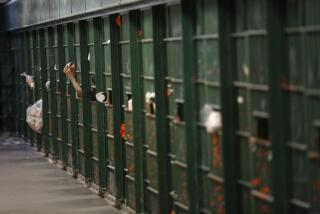Two of Mexico’s most notorious criminals are in custody in the United States
One is an American citizen who rose through the ranks of one of Mexico’s most vicious drug cartels. The other is a former cop who left the police force to take up a life of crime.
Edgar “La Barbie” Valdez Villarreal and Jorge Eduardo “El Coss” Costilla Sanchez were in custody in the United States on Thursday after their extraditions from Mexico. The two men, both with reputations as cold-blooded killers, are the most notorious among 13 suspects sent to the U.S. in an unusually high-level judicial transfer.
The move followed the escape of Joaquin “El Chapo” Guzman from a high-security prison this year. The Mexican authorities had refused to extradite Guzman despite requests from the United States, and analysts say that the extraditions Wednesday suggest a willingness on the part of the Mexican government to cooperate more and avoid any more embarrassing, high-profile escapes. Valdez and Costilla were being held in the same high-security prison from which Guzman escaped in July.
Here is a look at their background:
“La Barbie”
Valdez, 42, has a reputation as one of the most savage and deadly sicarios (killers) of the Beltran Leyva cartel. He is said to have dedicated his time at the criminal organization to choreographing executions, corrupting high-level Mexican officials and moving huge amounts of cocaine north – the Mexican authorities estimate that at the height of his success, Valdez was responsible for moving a ton of cocaine into the U.S. every month.
Valdez is better known as La Barbie because his light skin, blue eyes and blonde hair brought to mind a Barbie doll. The nickname was reportedly bestowed on him by his football coach at United High School in Laredo, Texas. Born in Laredo on Aug. 11, 1973, Valdez was raised in the United States but fled to Mexico after attracting heat for the marijuana dealing business he started while still in high school. Experts on Mexico’s drug-trafficking organizations say it is unusual for American citizens to feature high in their leadership ranks.
But Valdez had big ambitions, and worked his way up the ranks of the Beltran Leyva drug-trafficking organization, establishing a paramilitary group of executioners, reportedly called “Los Negros.” After the death of his boss, Arturo Beltran Leyva, in 2009, Valdez tried to wrest control of the cartel in a bloody struggle with Hector Beltran Leyva, Arturo’s brother and aspiring replacement. Valdez never fully succeeded.
“I think he got carried away with his own importance, “ says Duncan Wood, director of the Mexico Institute at the Wilson Center in Washington.
“Younger figures in organized crime get an over-inflated sense of their own importance; they believe they can get away with anything. There’s a sense of supreme power that they get,” he said.
That confidence and sense of importance was evident after his arrest in August 2010, when he was paraded before journalists wearing a dark green Ralph Lauren Polo T-shirt, a clothing choice that sent sales of pirated versions of Polo shirts in Mexico City rocketing. Valdez looked calm, confident and wore a knowing smile before national and international media.
That smile may have faded a little. Newspaper reports in Mexico said that Valdez suffers from acute dermatitis, and that his delicate skin deteriorated in prison without access to the expensive skin creams and treatments to which he was accustomed.
Ricardo Ravelo, who covered drug trafficking for the Mexican news magazine Proceso for 20 years, described Valdez as “deeply unbalanced.” News reports in Mexico about Valdez quote confidential reports from the Mexican attorney general’s office that say Valdez has a psychopathic personality and narcissistic tendencies, and that he enjoys being the center of attention.
“El Coss”
Costilla, 44, also known as “El Coss” (an abbreviation of Costilla), had a $5-million FBI reward on his head before he was caught in 2012 by Mexican marines in the city of Tampico, in Tamaulipas state.
He is believed to have joined the Gulf cartel as a sicario in the late 1990s, eventually rising to the top of the organization.
“You don’t rise to the top of an organization like that by chance,” Wood said.
Costilla had a good grounding in criminal behavior before he joined the Gulf cartel: He was a police officer in the city of Matamoros. He left the police to dedicate his time to theft and burglary, according to Ravelo.
“He became an important leader within the ranks of the Gulf cartel but always maintained a low profile. For years there were very few photos of him,” Ravelo said.
Costilla was reported to have been involved in a standoff with two U.S. federal agents in Matamoros in 1999 after the agents — one from the FBI and one from the Drug Enforcement Agency — were stopped at gunpoint at a checkpoint when members of the Gulf cartel discovered that they were transporting a Mexican informant. News reports from the time say that Costilla and Osiel Cardenas Guillen, the head of the Gulf cartel at the time, were both present at the checkpoint and that they eventually let the U.S. agents go, along with the informant.
Costilla’s role in the cartel grew when Cardenas Guillen was arrested in 2003 and extradited to the United States four years later. Costillo took on its leadership alongside Osiel’s brother Antonio, and oversaw one of the most violent chapters of its existence when the cartel’s armed branch, the Zetas, decided to break away and form a separate cartel in 2010.
That led to a brutal war between the Gulf cartel and the Zetas that played out in Tamaulipas, Nuevo Leon and Veracruz.
Bonello is a special correspondent. Cecilia Sanchez in The Times’ Mexico City bureau contributed to this report.
ALSO:
Russian warplanes strike targets in Syria
Migrants in Serbia wait in limbo for news of the next open border
Welcome home, 500 years later: Spain offers citizenship to Sephardic Jews
More to Read
Start your day right
Sign up for Essential California for news, features and recommendations from the L.A. Times and beyond in your inbox six days a week.
You may occasionally receive promotional content from the Los Angeles Times.






